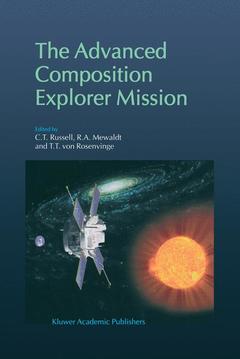Description
The Advanced Composition Explorer Mission, 1998
Coordinators: Russell C.T., Mewaldt R.A., von Rosenvinge T.T.
Language: English
Subjects for The Advanced Composition Explorer Mission:
Keywords
Corona; Heliosphere; Planet; Solar; Solar flare; Solar wind; Sun
Publication date: 11-2012
663 p. · 16x24 cm · Paperback
663 p. · 16x24 cm · Paperback
Description
/li>Contents
/li>
NASA's Advanced Composition Explorer (ACE) was launched on August 25, 1997, carrying six high-resolution spectrometers that measure the abundances of the elements, isotopes, and ionic charge states of energetic nuclei in space. Data from these instruments is being used to measure and compare the composition of the solar corona, the nearby interstellar medium, and cosmic-ray sources in the Galaxy, and to study particle acceleration processes in a variety of environments. ACE also includes three instruments that monitor solar wind and energetic particle activity near the inner Lagrangian point, "1.5 million kilometers sunward of Earth, and provide continuous, real-time data to NOAA for use in forecasting space weather. Eleven of the articles in this volume review scientific progress and outline questions that ACE will address in solar, space-plasma, and cosmic-ray physics. Other articles describe the ACE spacecraft, the real-time solar-wind system, and the instruments used to measure energetic particle composition.
The Advanced Composition Explorer.- Challenges for the Advanced Composition Explorer.- On the Slow Solar Wind.- Wind Observations of Suprathermal Electrons in the Interplanetary Medium.- Particle Acceleraton in Impulsive Solar Flares.- Interstellar Matter and the Boundary Conditions of the Heliosphere.- Interstellar and Inner Source Pickup Ions Observed with SWICS on Ulysses.- Insights into Cosmic-Ray Acceleration from the Study of Anomalous Cosmic Rays.- A Cosmic-Ray Composition Controlled by Volatility and A/Q Ratio. SNR Shock Acceleration of Gas and Dust.- Cosmic Rays from Supernova Remnants: A Brief Description of the Shock Acceleration of Gas and Dust.- Cosmic-Ray Clocks.- What Are the Limits for ACE Galactic Cosmic-Ray Isotope Studies?.- ACE Spacecraft.- The Cosmic-Ray Isotope Spectrometer for the Advanced Composition Explorer.- The Solar Isotope Spectrometer for the Advanced Composition Explorer.- The Ultra-Low-Energy Isotope Spectrometer (ULEIS) for the ACE Spacecraft.- The Solar Energetic Particle Ionic Charge Analyzer (SEPICA) and the Data Processing Unit (S3DPU) for SWICS, SWIMS and SEPICA.- Investigation of the Composition of Solar and Interstellar Matter using Solar Wind and Pickup Ion Measurements with SWICS and SWIMS on the ACE Spacecraft.- Electron, Proton, and Alpha Monitor on the Advanced Composition Explorer Spacecraft.- Solar Wind Electron Proton Alpha Monitor (SWEPAM) for the Advanced Composition Explorer.- The ACE Magnetic Fields Experiment.- The NOAA Real-Time Solar-Wind (RTSW) System Using ACE Data.- The ACE Science Center.
© 2024 LAVOISIER S.A.S.




